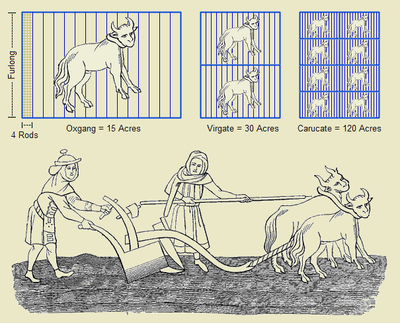Virgate

- The rod is a historical unit of length equal to 5½ yards. It may have originated from the typical length of a mediaeval ox-goad.
- The furlong (meaning furrow length) was the distance a team of oxen could plough without resting. This was standardised to be exactly 40 rods.
- An acre was the amount of land tillable by one man behind one ox in one day. Traditional acres were long and narrow due to the difficulty in turning the plough.
- An oxgang was the amount of land tillable by one ox in a ploughing season. This could vary from village to village, but was typically around 15 acres.
- A virgate was the amount of land tillable by two oxen in a ploughing season.
- A carucate was the amount of land tillable by a team of eight oxen in a ploughing season. This was equal to 8 oxgangs or 4 virgates.
Virgate as a term applies to metrology as a unit of land, and in morphology as a description of the habit of certain plants.
Historical metrology
The virgate (Medieval Latin: virgāta) or yardland (Middle English: yardland) was a unit of land area measurement used in medieval England, typically outside the Danelaw, and was held to be the amount of land that a team of two oxen could plough in a single annual season. It was equivalent to a quarter of a hide, so was nominally thirty acres.[1] A ‘virgater’ would thus be a peasant who occupied or worked this area of land, and a ‘half virgater’ would be a person who occupied or worked about 15 acres (61,000 m2).
The Danelaw equivalent of a virgate was two oxgangs, or ‘bovates’:[2] as these names imply, the oxgang or bovate was considered to represent the amount of land that could be worked in a single annual season by a single ox, and therefore equated to half a virgate. As such, the oxgang represented a parallel division of the carucate. Accordingly, a 'bovater' is the Danelaw equivalent of a half virgater.
‘Virgate’ is an anglicisation of the Medieval Latin virgata. In some parts of England, it was divided into four nooks (Middle English: noke; Medieval Latin: noca).[3] Nooks were occasionally further divided into a farundel (Middle English: ferthendel; Old English: fēorþan dǣl, "fourth deal, fourth share").[4]
Botanical terminology

Virgate in botany and related disciplines is an adjective derived from the Latin virgatus, meaning in part, "made of twigs" or "striped". In current botanical usage it most often refers to plants with wand-shaped, erect branches or stems. the diminutive is "virgulate".[5] The term occurs commonly in the biological names of plants, such as Vaccinium virgatum or Chloris virgata.
Mycological terminology

Virgate, and particularly virgulate, also can mean "finely striped" and the terms are used accordingly in mycology. In describing a pileus or "cap" of a mushroom, it refers to radiating stripes or ribs, as in Tricholoma virgatum.[5]
References
- ↑ D. Hey ed., Oxford Companion to Local and Family History (Oxford University Press, Oxford, 1996), 476.
- ↑ Stephen Friar, Batsford Companion to Local History (Batsford, London 1991), 270.
- ↑ "Noca - nook (measure of land)" R. W. Latham, Revised Mediaval Latin Word-list (Oxford University Press, London: for British Academy 1965), 312.
- ↑ Bosworth, Joseph; T. Northcote Toller (1882). An Anglo-Saxon Dictionary. Oxford University Press. p. 281.
- ↑ 5.0 5.1 Jackson, Benjamin, Daydon; A Glossary of Botanic Terms with their Derivation and Accent; Published by Gerald Duckworth & Co. London, 4th ed 1928